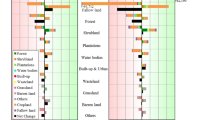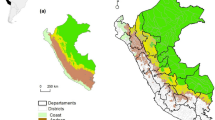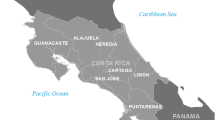Abstract
The southern Yucatán has been identified as a deforestation hot spot. Land-change studies document the extent of forest loss at a regional scale, and case studies provide insights into the drivers of deforestation at the household level. Those studies have paid minimal attention to sub-regional analysis, especially to discrete land-management units above the household level. This analysis of upland forest change addresses the range of variation in deforestation among 96 ejidos (communal lands) and the Calakmul Biosphere Reserve, the two dominant land-tenure and land-management units in the region. Satellite imagery, census, and land-tenure data are used to establish the extent and location of deforestation patterns, and multivariate techniques are employed to identify biophysical and socioeconomic variables that explain such patterns. Results show that, for the 1984–1993 period, deforestation in the southern Yucatán was not as prevalent as implied by its hot spot designation. Three clusters of deforestation are identified. A logistic regression analysis establishes that size of forest holdings, population growth, and location in the precipitation gradient correlate with ejidos that experienced higher deforestation rates than the rest of the land-tenure units. For the 1993–2000 period, conservation programs and changes in the economic context of this “hollow frontier” contributed to reduce deforestation rates and extent. This analysis illustrates the spatio-temporal heterogeneity of much tropical forest change and caution that it should bring to simple formulations of modeling this change and prescribing policies to control it.





Similar content being viewed by others
Notes
The SYPR is a multi-disciplinary and multi-institutional project examining land dynamics in the southern Yucatan operating since 1997. The project joins environmental, social, and GIS/remote sensing sciences to address land-use/cover change in its own right as foundational to a series of forest ecology, socioeconomic development, and coupled systems issues (Turner et al. 2004).
The SYPR project’s original study region approximates 22,000 km2. If, however, only those land-management units residing fully within the project’s bounds are considered (Fig. 1), then the area is reduced to 19,000 km2.
The 14 classes and their clusters are as follows: (1) Seasonally Inundated Vegetation and Wetland Forests that include Selva Baja Inundable (regularly inundated low-statured forest) and Tulare and Savannas (variably inundated grasslands and marsh); (2) a Transitional Forest category that includes only one class, Selva Baja (irregularly inundated low-statured forest often on edges of seasonal wetlands); (3) Upland Forests that include Selva Alta and Mediana Perennifolia (high-stature semi-evergreen upland forest), Selva Mediana Subperennifolia (medium-stature semi-evergreen upland forest), and Selva Baja and Mediana Subcaducifolia (medium and low-stature semi-deciduous and deciduous upland forest); and (4) Modified Vegetation that includes the Herbaceous secondary, Shrubby secondary, and Arboreous secondary vegetation and Bracken Fern (an invasive species, Pteridium aquilinum), Crop cultivation (milpa/swidden and chili cultivation), Pasture, and Bare Surfaces. Water bodies were classified as a separate category.
The precipitation gradient emerges as the critical variable because, in part, other biophysical factors could not be treated in terms of their spatial specificity. The vast majority of the upland forests reside on redzina soils (mollisol order). Soil depth is linked to position on the catena and soil moisture, beyond rainfall characteristics, by slope angle and aspect. These micro-factors are considered here to be distributed relatively evenly throughout the region. See Foster and Turner (2004) for biophysical descriptions of the SY.
The ejidos are as follows: Conhuás (34.9 km2), Miguel Alemán (22.4 km2), Nicolás Bravo (20.9 km2), Tres Garantías (20.5 km2), Zoh Laguna (13.4 km2), Nuevo Becal (13.3 km2), Cristobal Colón (12.3 km2), Pablo García (12.0 km2), La Lucha 2 (9.8 km2), 20 de Noviembre (9.8 km2), Santa Rosa (9.1 km2) and Guillermo Prieto (8.0 km2). Miguel Alemán, Nicolás Bravo and Tres Garantías are all in Quintana Roo and have extensive forest. Conhuás and Zoh Laguna belong to Campeche and they also enjoy large forestry extensions.
References
Abizaid C, Coomes OT (2004) Land use and forest fallowing dynamics in seasonally dry tropical forests of the southern Yucatan peninsula. Land Use Policy 21(1):71–84
Achard F, Eva HD, Glinnin A, Mayaux P, Richards T, Stibig HJ (1998) Identification of deforestation hot spot areas in the humid tropics: synthesis of the results of an expert consultation meeting. Publication of the European Communities, Luxembourg. doi:EUR 18079 EN
Alix-Garcia J (2004) Seeing the forest and the trees: a spatial analysis of common property deforestation. In: Job market paper, University of California at Berkeley. Available via DIALOG. http://www.are.berkeley.edu/~alix/JMP.pdf. Accessed 17 Nov 2006
Bray DB, Klepeis P (2005) Deforestation, forest transitions, and institutions for sustainability in southeastern Mexico, 1900–2000. Environ Hist 11:195–223
Bray DB, Ellis EA, Armijo-Cantoc N, Beck CT (2004) The institutional drivers of sustainable landscapes: a case study of the ‘Mayan Zone’ in Quintana Roo, Mexico. Land Use Policy 21(1):333–346
Brondizio E (2006) Intraregional analysis of land-use change in the amazon. In: Moran E, Ostrom E (eds) Seeing the forest and the trees. MIT Press, Cambridge, MA, pp 223–252
Chomitz KA, Gray DA (1995) Roads, lands, markets, and deforestation, a spatial model of land-use in Belize. Policy research working paper 1444. The World Bank, Policy Research Department, Washington, DC
Cropper M, Griffiths C, Mani M (1999) Roads, population pressures, and deforestation in Thailand 1976–1989. Land Econ 75:58–73
Diario Oficial (1989) Decreto Nacional, Estados Unidos Mexicanos, 23 de Mayo
FAO (Food, Agricultural Organization of the United Nations) (2005) Global forest resources assessment. FAO, Roma
Flachsenberg H, Galletti HA (1999) El Manejo Forestal de la Selva en Quintana Roo, México. In: Primack R, Bray D, Galletti H, Ponciano I (eds) La Selva Maya, Conservación y Desarrollo. Siglo Veintiuno Editores, México, DF, pp 74–97
Foster D, Turner BL II (2004) The long view: human-environment relationships, 1000BC–AD 1900. In: Turner BL II, Geoghegan J, Foster D (eds) Integrated land-change science and tropical deforestation in the Southern Yucatán final frontiers. Oxford University Press, Oxford, pp 23–28
Galletti HA (1999) La Selva Maya en Quintana Roo (1983–1996) Trece Años de Conservación y Desarrollo Comunal. In: Primack R, Bray D, Galletti H, Ponciano I (eds) La Selva Maya, Conservación y Desarrollo. Siglo Veintiuno Editores, México, DF, pp 53–72
Geist HJ, Lambin EF (2002) Proximate causes and underlying forces of tropical deforestation. Bioscience 52(2):143–150
Geoghegan J, Cortina Villar S, Klepeis P, Macario Mendoza P, Ogneva-Himmelberger Y, Roy Chowdhury R, Turner BLII, Vance C (2001) Modeling tropical deforestation in the southern Yucatan peninsular region: comparing survey and satellite data. Agric Ecosyst Environ 85:25–46
Geoghegan J, Schneider LC, Vance C (2004) Spatially explicit, statistical land-change models in data-sparse conditions. In: Turner BL II, Geoghegan J, Foster D (eds) Integrated land-change science and tropical deforestation in the Southern Yucatán final frontiers. Oxford University Press, Oxford, pp 247–270
Geoghegan J, Schneider LC, Vance C (2005) Temporal dynamics and spatial scales: modeling deforestation in the southern Yucatan peninsular region. GeoJournal 61:353–363
Gibbs HK, Brown S, Niles JO, Foley JA (2007) Monitoring and estimating tropical forest carbon stocks: making REDD a reality. Environ Res Lett 2. doi:10.1088/1748-9326/2/4/045023
Giri C, Defourney P, Shresta S (2003) Land cover characterization and mapping of continental Southeast Asia using multi-resolution satellite sensor data. Int J Remote Sens 24(21):4181–4196
Grainger A (2008) Difficulties in tracking the long-term global trend in tropical forest area. Proc Natl Acad Sci USA 105:818–823
Haenn N (2005) Fields of power, forests of discontent: culture, conservation and the state in Southern Mexico. University of Arizona Press, Tucson
Hair JF Jr, Anderson R, Tatham RL, Black WC (1998) Multivariate data analysis. Prentice-Hall, Upper Saddle River
Harvey N (1996) The reshaping of agrarian policy in Mexico. In: Randall L (ed) Changing structure of Mexico: political, social, and economic prospects. M. E. Sharpe, Armonk, pp 103–110
IADB (Inter-American Development Bank) (2003) IDB to host launching of the Mundo Maya Sustainable Tourism Development Program and Strategic Alliance. IADB Press. Available via DIALOG. http://www.Iadb.org/exr/PRENSA/2003/cp1003e.htm. Accessed 08 Dec 2006
INEGI (Instituto Nacional de Estadística, Geografía e Informática) (1982, 1992, 2007) National census of population and housing. INEGI, Mexico DF
Kaimowitz D, Angelsen A (1998) Economic models of tropical deforestation, a review. CIFOR, Bangor
Kaimowitz D, Mendez P, Puntodewo A, Vanclay JK (2002) Spatial regression analysis of deforestation in Santa Cruz, Bolivia. In: Wood CH, Porro R (eds) Deforestation and land use in the Amazon. University Press of Florida, Gainesville, pp 41–65
Kauppi PE, Ausubel JH, Fang J, Mather AS, Sedjo RA, Waggoner PE (2006) Returning forests analyzed with the forest identity. Proc Natl Acad Sci USA 103(46):17574–17579
Keys E (2004) Chili Cultivation in the Southern Yucatan region: plant–pest disease as land degradation. Land Degrad Dev 15(4):397–409
Keys E (2005) Exploring market based development: market intermediaries and farmers in Calakmul, Mexico. Geogr Rev 95(1):24–46
Klepeis P (2000) Deforesting the once deforested: integrated land history of the Southern Yucatan Peninsular Region. Dissertation, Clark University
Klepeis P (2003) Development policies and tropical deforestation in the southern Yucatán Peninsula: centralized and decentralized approaches. Land Degrad Dev 14:541–561
Klepeis P, Roy Chowdhury R (2004) Institutions, organizations, and policy affecting land change: complexity within and beyond the Ejido. In: Turner BL II, Geoghegan J, Foster D (eds) Integrated land-change science and tropical deforestation in the Southern Yucatán final frontiers. Oxford University Press, Oxford, pp 145–170
Laurance WF (1999) Reflections on the tropical deforestation crisis. Biol Conserv 9:109–117
Lawrence D, Vester HFM, Eastman JR, Turner BL II, Geoghegan J (2004) Integrated analysis of ecosystem interactions with land-use change: the Southern Yucatán Peninsular Region. In: DeFries R (ed) Ecosystems and land use change. American Geophysical Union, Washington, DC
Lundell CL (1933) The agriculture of the Maya. Southwest Rev 19:65–77
Lustig N (1998) Mexico: the remaking of an economy. Brookings Institution Press, Washington, DC
Mather AS (1992) The forest transition. Area 24:367–379
Miller K, Chang E, Johnson N (2001) Defining common ground for the Mesoamerican biological corridor. World Resources Institute, Washington, DC
Miranda F, Hernandez E (1963) Los tipos de vegetación de México y su clasificación. Boletín de la Sociedad Botánica de México 28:29–179
Moran E, Ostrom E (eds) (2006) Seeing the forest and the trees. MIT Press, Cambridge
Myers N (1988) Threatened biotas: “hot spots” in tropical forests. Environmentalist 8:187–208
Ostrom E, Janssen MA, Anderies JM (2007) Going beyond panaceas special feature: going beyond panaceas. Proc Natl Acad Sci USA 104:15176–15178
Pennington TD, Sarukhan J (1968) Manual para la Identificación de Campo de los Principales Árboles Tropicales de México. Instituto Nacional de Investigaciones Forestales, Secretaria de Agricultura y Ganadería, México DF
Perez-Salicrup D (2004) Forest types and their implications. In: Turner BL II, Geoghegan J, Foster D (eds) Integrated land-change science and tropical deforestation in the Southern Yucatán Final Frontiers. Oxford University Press, Oxford, pp 63–80
Pontius RG Jr, Malitzia NR (2004) Effect of category aggregation on map comparison. In: Egenhofer J, Freksa C, Miller HJ (eds) GIScience, LNCS 3234, pp 251–268
Primack R, Bray D, Galletti H, Ponciano I (eds) (1998) Timber, tourists, and temples. Conservation and development in the Maya Forest of Belize, Guatelama and Mexico. Island Press, Washington, DC
Radel C (2005) Women’s community-based organizations, conservation projects, and effective land control in Southern Mexico. J Latin Am Geogr 4(2):7–34
Radel C, Schmook B (2008) Mexican male transnational migration and its linkages to land use change in a Southern Campeche Ejido. J Latin Am Geogr 7(2):59–84
Roy Chowdhury R, Schneider LC (2004) Land cover and land use: classification and change analysis. In: Turner BL II, Geoghegan J, Foster D (eds) Integrated land-change science and tropical deforestation in the Southern Yucatán Final Frontiers. Oxford University Press, Oxford, pp 105–141
Roy Chowdhury R, Turner BL II (2006) Reconciling agency and structure in empirical analysis: smallholder land use in Southern Yucatan, Mexico. Ann Assoc Am Geogr 96(2):302–322
Rudel TK (2005) Forests: regional paths of destruction and regeneration in the late twentieth century. Columbia University Press, New York
Rudel TK, Coomes OT, Moran E, Achard F, Angelsen A, Xuf J, Lambin E (2005) Forest transitions: towards a global understanding of land use change. Glob Environ Change 15:23–31
Rudel TK, Schneider L, Uriarte M, Turner BLII, DeFries R, Lawrence D, Geoghegan J, Hecht S, Ickowitz A, Lambin EF, Birkenholtz T, Baptista S, Grau R (2009) Agricultural intensification and changes in cultivated areas, 1970–2005. Proc Natl Acad Sci USA 106(49):20675–20680
Rueda X (2007) Landscapes in transition: land-use change, conservation and structural adjustment in the southern Yucatan. Dissertation, Clark University
Schmook B, Radel C (2008) International labor migration from a tropical development frontier: globalizing households and an incipient forest transition the Southern Yucatán case. Hum Ecol 36(6):891–908
Schmook B, Dickson R, Sangermano, Vadjunec J, Eastman RJ, Rogan J (2010) A step-wise land cover classification of the tropical forests of the Southern Yucatán, Mexico. Int J Remote Sens (forthcoming)
Schneider LC (2004) Bracken fern invasion in Southern Yucatán: a case for land-change science. Geogr Rev 94(2):229–241
Schneider LC (2006) Invasive species and land-use: the effect of land management practices on bracken fern invasion in the region of Calakmul, Mexico. J Latin Am Geogr 5(2):91–107
Smith JH, Wickham JD, Stehman SV, Yang L (2002) Impacts of patch size and land-cover heterogeneity on thematic image classification. Photogramm Eng Remote Sensing 68(1):65–70
Sohn Y, Moran E, Gurri F (1999) Deforestation in North Central Yucatan (1985–1995): mapping secondary succession of forest and agricultural land use in Sotuta using the cosine of the angle concept. Photogramm Eng Remote Sensing 65(8):947–958
Studenmund AH (2006) Using econometrics: a practical guide, 5th edn. Addison Wesley, Reading, MA, pp 258–259
TNC (The Nature Conservancy) (2006) Parks in peril. Available via DIALOG. Available online at: http://www.nature.org/wherewework/northamerica/mexico/work/art8631.html. Accessed 15 Mar 2007
Trejo RI, Dirzo R (2000) Deforestation of seasonally dry tropical forest towards its northern distribution: a national and local analysis in Mexico. Biol Conserv 94:133–142
Tucker CM, Southworth J (2006) Processes of forest change at the local and landscape levels in Honduras and Guatemala. In: Moran E, Ostrom E (eds) Seeing the forest and the trees. MIT Press, Cambridge, pp 253–279
Tucker CJ, Townshend JRG (2000) Strategies for monitoring tropical deforestation using satellite data. Int J Remote Sens 21:1461–1475
Turner BL II, Geoghegan J, Foster D (eds) (2004) Integrated land-change science and tropical deforestation in the Southern Yucatán Final Frontiers. Oxford University Press, Oxford
Van Laake PE, Sanchez Azofeifa GA (2004) Focus on deforestation: zooming in on hot spots in highly fragmented ecosystems in Costa Rica. Agric Ecosyst Environ 102:3–15
Vance C, Geogheghan J (2002) Temporal and spatial modeling of tropical deforestation: a survival analysis linking satellite and household survey data. Agric Econ 27:1–16
Vester HF, Lawrence D, Eastman JR, Turner BL II, Calme S, Dickson R, Pozo C, Sangermano F (2007) Land change in the Southern Yucatán and Calakmul biosphere reserve: implications for habitat and biodiversity. Ecol Appl 17(4):989–1003
Waggoner PE (2009) Forest inventories: discrepancies and uncertainties. Discussion paper, Resources for the future, Washington, DC
Watson RT, Noble IR, Bolin B, Ravindranath NH, Verardo DJ, Dokken DJ (2000) Land use, land-use change, and forestry: a special report of the intergovernmental panel on climate change. Cambridge University Press, Cambridge
World Bank(1990) Project completion report Mexico integrated rural development project—Pider Iii (Loan 2043-Me). The World Bank, Washington, DC
Acknowledgments
This paper is the product of the Southern Yucatán Peninsular Region (SYPR) project involving Clark University, University of Virginia, El Colegio de la Frontera Sur, and Harvard University. Core funding for the SYPR project from 1997 to 2009 was provided by NASA’s LCLUC program (NAG 56046, 511134, 06GD98G) and NSF’s BCS program (0410016). The project is indebted to assistance provided by our host institution in Mexico, El Colegio de la Frontera Sur, especially Unidad Chetumal. My deepest thanks to Birgit Schmook from ECOSUR for her valuable insight and assistance in the field, as well as her comments to this manuscript, to Natalia Alfonso who provided insights on the statistical methods, to Santiago Silva for helping me improve the graph, and to B. L. Turner II, John Rogan, Oliver Coomes, and Sam Ratick who read this manuscript, provided comments, and suggested clarifications throughout.
Author information
Authors and Affiliations
Corresponding author
Rights and permissions
About this article
Cite this article
Rueda, X. Understanding deforestation in the southern Yucatán: insights from a sub-regional, multi-temporal analysis. Reg Environ Change 10, 175–189 (2010). https://doi.org/10.1007/s10113-010-0115-7
Received:
Accepted:
Published:
Issue Date:
DOI: https://doi.org/10.1007/s10113-010-0115-7




